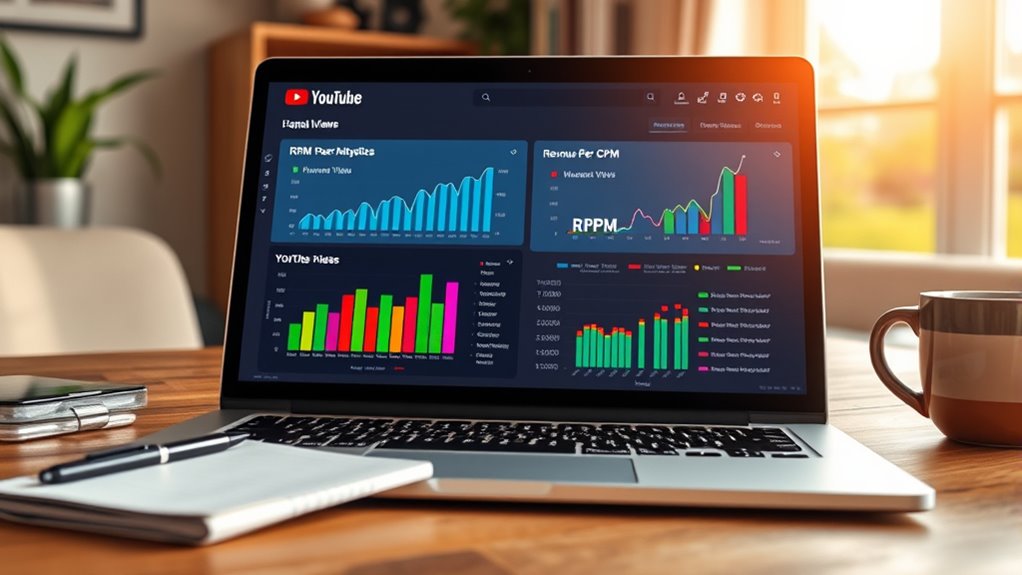Understanding the difference between CPM and RPM is key to knowing your actual earnings. CPM shows how much advertisers pay per thousand ad views, but it doesn’t reflect your real income after YouTube’s cut and other revenue streams. RPM represents your true earnings per thousand views, including all income sources. While CPM indicates potential, RPM gives a clearer picture of your channel’s performance. Keep exploring to discover how these metrics work together to impact your earnings.
Key Takeaways
- CPM measures potential ad revenue per 1,000 views before YouTube’s cut, while RPM reflects actual earnings after deductions.
- RPM provides a more accurate picture of a creator’s real income per 1,000 views.
- A high CPM doesn’t guarantee high earnings if viewer engagement and ad impressions are low.
- Focusing on increasing RPM helps assess overall channel profitability and income stability.
- Both metrics are important; CPM indicates ad value potential, RPM shows actual revenue earned.

Understanding the difference between YouTube RPM and CPM is essential for creators aiming to maximize their earnings. These two metrics influence how much money you make from your videos, but they do so in different ways. CPM, or cost per thousand impressions, tells you how much advertisers are willing to pay for every thousand ad views on your content. It’s straightforward: if your CPM is $5, you earn $5 for every 1,000 monetized views that trigger ads. However, CPM doesn’t account for all factors that affect your total revenue. Your actual earnings depend heavily on ad revenue, which is influenced by how many viewers see ads and how engaged they are with your content. Audience engagement plays a vital role here. When your viewers interact more with your videos—by liking, commenting, and sharing—they’re more likely to watch longer, which increases the chances of ads being shown and clicked. This, in turn, boosts your ad revenue and can raise your effective CPM. But CPM alone doesn’t tell the full story. If your audience isn’t engaging or if only a small portion of your viewers see ads, your CPM might be high, yet your overall earnings could be lower than expected. That’s why many creators focus on fostering a loyal, engaged community that not only watches your videos but actively interacts with them, increasing the likelihood of ad impressions and clicks.
Understanding YouTube CPM and RPM helps creators maximize earnings and optimize audience engagement.
On the other hand, RPM, or revenue per thousand views, reflects your actual earnings after YouTube takes its cut and considers factors like ad revenue, channel memberships, super chats, and other income streams. RPM gives you a more accurate picture of what you’re earning per thousand views, making it a valuable metric for tracking your overall channel performance. If your RPM is $3, it means you’re earning about $3 for every 1,000 views, regardless of how much advertisers are paying. This makes RPM especially useful for understanding your true income, especially when ad revenue fluctuates due to seasonal trends or changes in advertiser demand. Monitoring content performance and audience behavior can help optimize both metrics over time. Ultimately, both metrics matter, but RPM offers a clearer picture of your real earnings, while CPM helps you understand the potential ad value per impression. As a creator, it’s essential to focus on increasing audience engagement to maximize ad revenue, which can positively influence both your RPM and CPM. By creating content that resonates with your viewers and encourages interaction, you’ll improve not just your ad revenue but your overall earning potential on YouTube.
Frequently Asked Questions
How Can I Improve My Youtube RPM?
To improve your YouTube RPM, focus on boosting audience engagement and integrating affiliate marketing strategies. Create compelling content that encourages viewers to like, comment, and share, which increases watch time and revenue. Promote relevant affiliate products subtly within your videos, earning extra income. Additionally, optimize your video titles, descriptions, and tags to attract targeted viewers, ultimately raising your RPM by increasing overall earnings per thousand views.
What Factors Influence CPM Rates on Youtube?
YouTube’s CPM rates are influenced by factors like advertiser demand and seasonality trends. When more advertisers target your niche, CPM tends to rise. During peak seasons, such as holidays, demand increases further, boosting your rates. Keep an eye on these trends and tailor your content accordingly. By understanding how advertiser demand fluctuates and seasonality impacts rates, you can optimize your videos to maximize earnings.
Is RPM More Important Than CPM for Earnings?
You might think CPM is king, but RPM truly shows your real earnings after ad targeting and YouTube’s cut. Imagine earning $10 on a video, but with high CPM, your ad revenue might seem impressive—yet RPM reveals whether you actually keep enough to grow. RPM accounts for all factors affecting your income, making it more reliable for tracking your earnings. So, yes, RPM is more important for understanding your actual YouTube income.
How Does Viewer Location Affect RPM and CPM?
Viewer location substantially impacts your ad revenue, RPM, and CPM. When your audience is from high-paying countries like the US or UK, you’ll see higher CPM rates due to better ad demand and audience demographics. Conversely, viewers from lower-paying regions lower your overall RPM. You should target specific locations and understand your audience’s demographics to optimize your earnings and attract relevant advertisers, boosting your overall revenue.
Can My Niche Impact My RPM and CPM?
Your niche can substantially impact your RPM and CPM because niche optimization and audience targeting attract advertisers willing to pay more for specific content. If you focus on a high-value niche, like finance or tech, you’ll likely see higher rates. Conversely, broader or less targeted niches may generate lower RPM and CPM. Tailor your content to appeal to your ideal audience to maximize earnings and attract premium advertisers.
Conclusion
Understanding the difference between RPM and CPM helps you optimize your earnings on YouTube. Did you know that creators with higher engagement often see RPMs up to 20% higher than CPMs? This shows that focusing on viewer retention and interaction can boost your overall revenue. So, pay attention to RPM as it reflects your actual earnings per thousand views, making it the more valuable metric to track for long-term success.









